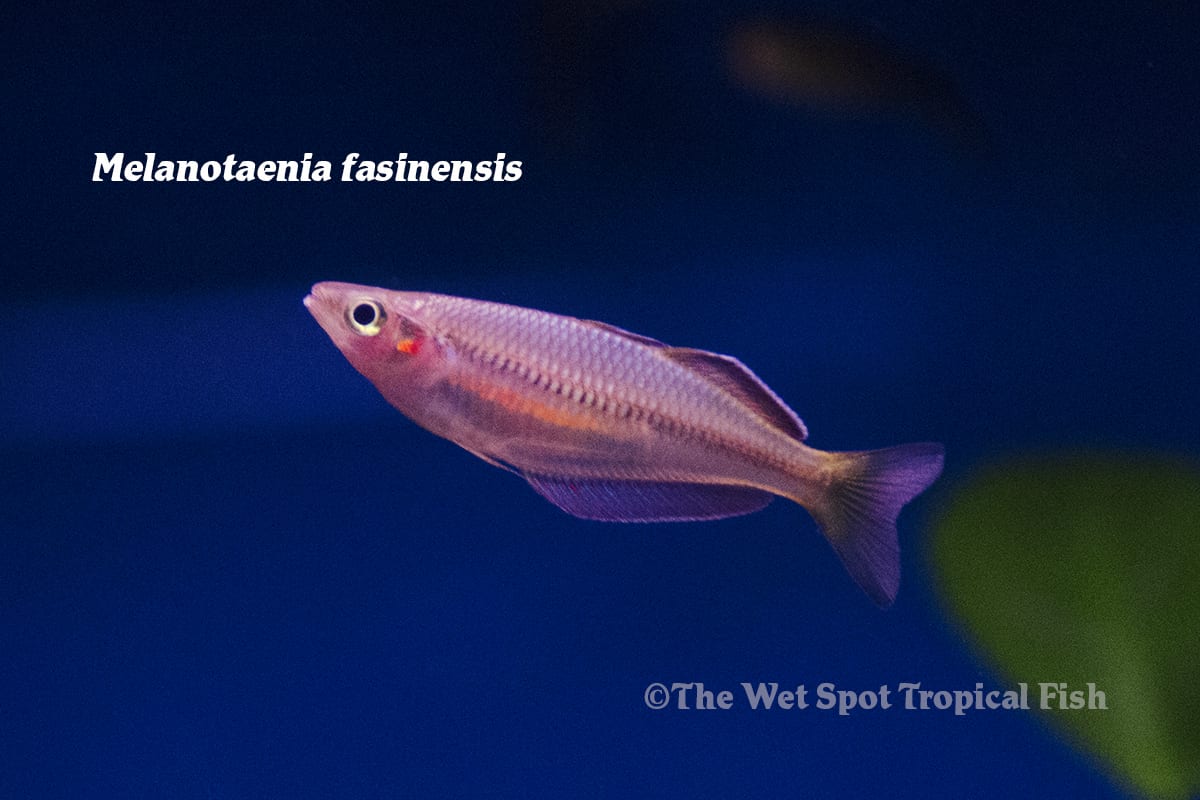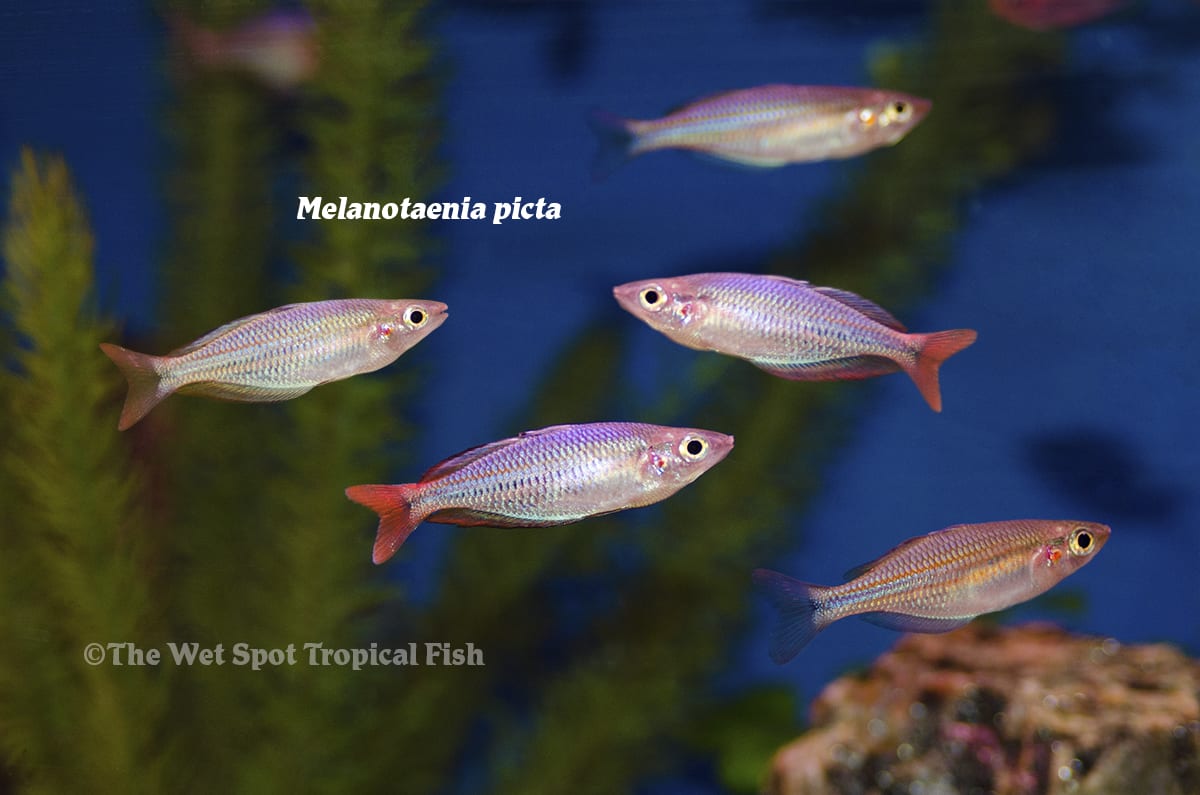Tied Up in a Rainbow
Tied Up in a Rainbow
The usual name of our game here at the Wet Spot is to highlight the unique characteristics of rare and beautiful freshwater fish. Some fish, however, sell themselves. For instance, if we told you we offer a large selection of hardy, peaceful, active, and colorful fish, wouldn’t you be intrigued? All of those descriptors apply to the commonly known, though less popular, rainbowfish. Let’s start with a few of our favorites: Chilatherina alleni, Melanotaenia fasinensis, Melanotaenia maccullochi, and Melanotaenia picta.
Scientific NameChilatherina alleni
Common NameAllen’s Rainbowfish
Temperature / pH75 to 88°F / 6.0 to 8.4 pH
Native LocationWapoga River
Preferred DietSmall invertebrates
Abundant in a range of habitats from lowland and rainforest creeks to mountain streams, C. alleni, was first collected in numerous Wapoga River tributaries in 1998, and can often be found under the name descriptor “Wapoga”. Also known as “Allen’s Rainbowfish”, this specimen generally inhabits brightly lit areas of their primary habitats, which is a great treat for all who look-on. These rainbowfish have extraordinary striping of brown, orange, dark blue, and turquoise coloration along teardrop-shaped bodies accentuated by elegant motion. Preferred habitats include moderately flowing tributary streams with leaf litter and log debris. In captivity, they do best in planted tanks with water temperatures between 75 and 88°F and a pH of 6.0 to 8.4. Generally observed munching on small crustaceans, aquatic insect larvae, other aquatic invertebrates, and even some terrestrial insects, these fish can be fed regular meals of live and frozen fare supplemented by high quality granular foods and pellets. All rainbowfish can follow these general dietary guidelines.
Scientific NameMelanotaenia fasinensis
Common NameFasinensis Rainbowfish
Temperature / pH77°F / 7.7 pH
Native LocationIndonesia
Preferred DietSmall invertebrates
Another graceful specimen, M. fasinensis has a beautiful bright red base color with dark red and pink horizontal striping, orange tint, and blue head, fins, and eyes. Commonly referred to as Fasinensis Rainbowfish, these gorgeous swimmers are indigenous to the Fasin tributary of the Kladuk River of Indonesia. This narrow stream provides habitat with the shallow, clear waters running through forested areas. Thus, they thrive in biotopes with gravelly or limestone substrate, littered with detritus and tree branches. Waters should be maintained with temperatures around 77°F, and a relatively neutral pH around 7.7. Rainbowfish do exhibit shoaling behavior and do best in groups. They can be kept peacefully amongst other small grouped fish, and numerous bottom dwellers like corydoras, plecos, and loaches.
Scientific NameMelanotaenia maccullochi
Common NameDwarf Rainbowfish
Temperature / pH68 to 86°F / 5.0 to 8.0 pH
Native LocationNew Guinea/Australia
Preferred DietSmall invertebrates
While rainbowfish generally grow larger than traditional schooling freshwater aquarium fish, not all rainbows follow this parameter. M. maccullochi, for instance, reaches a maximum of 2.8 inches in length, and is more commonly known as the “Dwarf Rainbowfish”. With this reduction in size, coloration does not follow suit. Bright red fins adorn shimmering pearlescent bodies with dark black horizontal stripes. Found in New Guinea and Australia, dwarf rainbowfish are found in a vast span of biotopes. They are extremely hardy, and can tolerate flowing streams, to still ponds with clear or tannin-stained waters. One consistency between habitats is that they are found in densely vegetative areas, and should be maintained in heavily planted tanks with plenty of swimming space in captivity. Waters should be kept with temperatures between 68 and 86°F and a pH of 5.0 to 8.0. For optimal behavior and coloration, keep these rainbows in consepcific groups of at least 8.
Scientific NameMelanotaenia picta
Common NamePicta Rainbowfish
Temperature / pH68 to 86°F / 5.0 to 8.0 pH
Native LocationAru Islands
Preferred DietSmall invertebrates
Native to the Mareremar Rivers, M. picta, or “Picta Rainbowfish”, are silver-blue metallic with golden fins edged in black, red caudal fins, and a dark mask-like black eye marking. The species epithet “picta” translates to “painted” in reference to their regal markings. Their natural habitat consists of limestone substrate with abundantly clear waters, minimal vegetation, and plentiful hiding places made from logs and twig-snags. Reaching around 3.5 inches in length, these shoalers are magnificent to observe. Native to the Aru Islands, this species is hard to come by in the trade and swims off the shelves quite quickly. Little is known with regards to optimal tank-water conditions, though general rainbowfish care can be followed.
Looking for some fun and easy shoaling fish for your tropical community tanks? Perhaps, this time, bypass the solid, though routine tetras and barbs for the majesty of rainbowfish.



